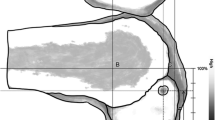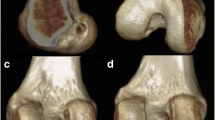Abstract
Accurate placement of the femoral tunnel position is an important aspect of cruciate ligament reconstruction surgery. However, a wide range of positions have been described in the literature for the femoral tunnels for posterior cruciate ligament (PCL) reconstruction, and there is no consensus regarding the optimal placement. It was hypothesised that some of the prior studies used femoral PCL graft tunnels that were outside of the anatomical attachments. A systematic review and descriptive anatomical study in vitro were undertaken. Fifty articles that described PCL reconstruction since 1917 were reviewed; the description of the femoral tunnel placement was reproducible from only 20 of these. A right, distal femur was disarticulated and the PCL attachment was dissected; the centres of the anterolateral and posteromedial bundles were marked and confirmed to be close to the mean published data. The tunnel positions described in the 20 papers were also marked. The descriptions of 15 of the 20 anterolateral and 4 of the 5 posteromedial bundle tunnel centres were close (within ±2 mm deep and ±01:00 o’clock) to the anatomical centres of the bundle attachments. Other tunnels were placed either deeper or shallower than the anatomical attachments. The mean positions were: 7 mm from the articular cartilage at 1 o’clock for the anterolateral bundle, and 8 mm from the cartilage at 3 o’clock for the posteromedial bundle, in a right knee. It was concluded that it was not possible to replicate the tunnel positions used in most of the literature because of inadequate descriptions. Most of the usable descriptions of the anterolateral bundle position were close to the anatomical centre, but some tunnels were placed non-anatomically. A reproducible system for description of the femoral tunnel positions should be used.



Similar content being viewed by others
References
Aglietti P, Buzzi R, Lazzara D (2002) Posterior cruciate ligament reconstruction with the quadriceps tendon in chronic injuries. Knee Surg Sports Traumatol Arthrosc 10:266–273
Ahn JH, Chung YS, Oh I (2003) Arthroscopic posterior cruciate ligament reconstruction using the posterior trans-septal portal. Arthrosc 19:101–107
Amis AA, Beynnon B, Blankevoort L, Chambat P, Christel P, Durselen L, Friederich N, Grood E, Hertel P, Jakob R et al (1994) Proceedings of the ESSKA scientific workshop on reconstruction of the anterior and posterior cruciate ligaments. Knee Surg Sports Traumatol Arthrosc 2:124–132
Chen CH, Chen WJ, Shih CH, Chou SW (2004) Arthroscopic posterior cruciate ligament reconstruction with quadriceps tendon autograft: minimal 3 years follow-up. Am J Sports Med 32:361–368
Christel P (2003) Basic principles for surgical reconstruction of the PCL in chronic posterior knee instability. Knee Surg Sports Traumatol Arthrosc 11:289–296
Clancy WG, Shelbourne KD, Zoellner GB, Keene JS, Reider B, Rosenberg TD (1983) Treatment of knee joint instability secondary to rupture of the posterior cruciate ligament. Report of a new procedure. J Bone Jt Surg [Am] 65:310–322
Cooper DE, Stewart D (2004) Posterior cruciate ligament reconstruction using single-bundle patella tendon graft with tibial inlay fixation: 2- to 10-year follow-up. Am J Sports Med 32:346–360
Edwards A, Bull AMJ, Amis AA (2007) The attachments of the fiber bundles of the posterior cruciate ligament: an anatomic study. Arthrosc 23:284–290
Garofalo R, Jolles BM, Moretti B, Siegrist O (2006) Double-bundle transtibial posterior cruciate ligament reconstruction with a tendon-patellar bone-semitendinosus tendon autograft: clinical results with a minimum of 2 years’ follow-up. Arthrosc 22:1331–1338
Girgis FG, Marshall JL, Al Monajem ARS (1975) The cruciate ligaments of the knee joint: anatomical, functional and experimental analysis. Clinical Orthop Rel Res 106:216–231
Grood ES, Hefzy MS, Lindenfield TN (1989) Factors affecting the region of most isometric femoral attachments. Part I: the posterior cruciate ligament. Am J Sports Med 17:197–207
Gupte CM, Smith A, McDermott ID, Bull AMJ, Amis AA (2002) Meniscofemoral ligaments revisited. Anatomical study, age correlation and clinical implications. J Bone Joint Surg Br 84-B:846–851
Harner CD, Xerogeanes JW, Livesay GA, Carlin GJ, Smith BA, Kusayama T, Kashiwaguchi S, Woo SL (1995) The human posterior cruciate ligament complex: an interdisciplinary study. Ligament morphology and biomechanical evaluation. Am J Sports Med 23:736–745
Harner CD, Baek GH, Vogrin TM, Carlin GJ, Kashiwaguchi S, Woo SL (1999) Quantitative analysis of human cruciate ligament insertions. Arthrosc 15:741–749
Harner CD, Janaushek MA, Kanamori A, Yagi M, Vogrin TM, Woo SL (2000) Biomechanical analysis of a double-bundle posterior cruciate ligament reconstruction. Am J Sports Med 28:144–151
Hatayama K, Higuchi H, Kimura M, Kobayashi Y, Asagumo H, Takagishi K (2006) A comparison of arthroscopic single- and double-bundle posterior cruciate ligament reconstruction: review of 20 cases. Am J Orthop 35:568–571
Horwitz MT (1938) An investigation of the surgical anatomy of the ligaments of the knee joint. Surg Obstet Gynecol 57:287–292
In Y, Bahk WJ, Kwon OS (2004) Cross-pin femoral fixation for hamstring posterior cruciate ligament reconstruction. Arthrosc 20:e29–e33
Jung YB, Tae SK, Jung HJ, Lee KH (2004) Replacement of the torn posterior cruciate ligament with a mid-third patellar tendon graft with use of a modified tibial inlay method. J Bone Jt Surg [Am] 86-A:1878–1883
Kim SJ, Kim HK, Kim HJ (1999) Arthroscopic posterior cruciate ligament reconstruction using a one-incision technique. Clin Orthop Relat Res 359:156–166
Kim SJ, Shin ST, Kim HK, Jahng JS, Kim JS (2000) Comparison of 1- and 2-incision posterior cruciate ligament reconstructions. Arthrosc 16:268–278
Kim SJ, Park IS, Cheon YM, Ryu SW (2004) Double-bundle technique: endoscopic posterior cruciate ligament reconstruction using tibialis posterior allograft. Arthrosc 20:1090–1094
Lill H, Glasmacher S, Korner J, Rose T, Verheyden P, Josten C (2001) Arthroscopic-assisted simultaneous reconstruction of the posterior cruciate ligament and the lateral collateral ligament using hamstrings and absorbable screws. Arthrosc 17:892–897
Mannor DA, Shearn JT, Grood ES, Noyes FR, Levy MS (2000) Two-bundle posterior cruciate ligament reconstruction. An in vitro analysis of graft placement and tension. Am J Sports Med 28:833–845
Mariani PP, Becker R, Rihn J, Margheritini F (2003) Surgical treatment of posterior cruciate ligament and posterolateral corner injuries. An anatomical, biomechanical and clinical review. Knee 10:311–324
Mejia EA, Noyes FR, Grood ES (2002) Posterior cruciate ligament femoral insertion site characteristics. Importance for reconstructive procedures. Am J Sports Med 30:643–651
Morgan CD, Kalman VR, Grawl DM (1997) The anatomic origin of the posterior cruciate ligament: where is it? reference landmarks for PCL reconstruction. Arthrosc 13:325–331
Noyes FR, Medvecky MJ, Bhargava M (2003) Arthroscopically assisted quadriceps double-bundle tibial inlay posterior cruciate ligament reconstruction: an analysis of techniques and a safe operative approach to the popliteal fossa. Arthrosc 19:894–905
Noyes FR, Barber-Westin SD (2005) Posterior cruciate ligament replacement with a two-strand quadriceps tendon-patellar bone autograft and a tibial inlay technique. J Bone Joint Surg [Am] 87:1241–1252
Nyland J, Hester P, Caborn DN (2002) Double-bundle posterior cruciate ligament reconstruction with allograft tissue: 2-year postoperative outcomes. Knee Surg Sports Traumatol Arthrosc 10:274–279
Pinczewski LA, Thuresson P, Otto D, Nyquist F (1997) Arthroscopic posterior cruciate ligament reconstruction using four-strand hamstring tendon graft and interference screws. Arthrosc 13:661–665
Race A, Amis AA (1994) The mechanical properties of the two bundles of the human posterior cruciate ligament. J Biomech 27:13–24
Race A, Amis AA (1998) PCL reconstruction. In vitro biomechanical comparison of ‘isometric’ versus single and double-bundled ‘anatomic’ grafts. J Bone Joint Surg Br 80:173–179
Sidles JA, Larson RV, Garbini JL, Downey DJ, Matsen FA 3rd (1988) Ligament length relationships in the moving knee. J Orthop Res 6:593–610
Stahelin AC, Sudkamp NP, Weiler A (2001) Anatomic double-bundle posterior cruciate ligament reconstruction using hamstring tendons. Arthrosc 17:188–197
Wang CJ, Chen HS, Huang TW (2003) Outcome of arthroscopic single bundle reconstruction for complete posterior cruciate ligament tear. Injury 34:747–751
Wang CJ, Weng LH, Hsu CC, Chan YS (2004) Arthroscopic single- versus double-bundle posterior cruciate ligament reconstructions using hamstring autograft. Injury 35:1293–1299
Wang CJ, Weng LH, Yuan LJ, Chen HS (2004) Comparison of autogenous and allogenous posterior cruciate ligament reconstructions of the knee. Injury 35:1279–1285
Zavras TD, Amis AA (1998) Method for visualising and measuring the position of the femoral attachment of the ACL and ACL grafts in experimental work. J Biomech 31:387–390
Acknowledgments
The specimen used in this study was sourced from the International Institute for the Advancement of Medicine, Jessop, PA, USA. Mr. Apsingi received financial support for the purchase of knee specimens from Smith & Nephew Arthroscopy (UK) Ltd.
Author information
Authors and Affiliations
Corresponding author
Rights and permissions
About this article
Cite this article
Apsingi, S., Bull, A.M.J., Deehan, D.J. et al. Review: femoral tunnel placement for PCL reconstruction in relation to the PCL fibre bundle attachments. Knee Surg Sports Traumatol Arthrosc 17, 652–659 (2009). https://doi.org/10.1007/s00167-009-0747-7
Received:
Accepted:
Published:
Issue Date:
DOI: https://doi.org/10.1007/s00167-009-0747-7




